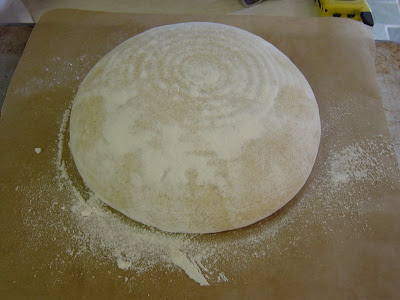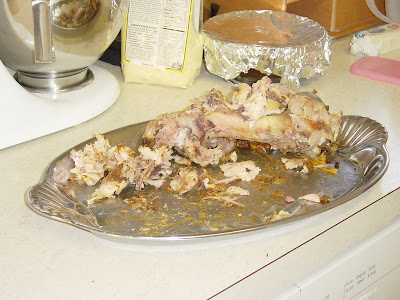This Friday was the first Friday of Lent. For us good Roman Catholics (What? Why are you laughing?), that means no meat on Fridays from now until Easter on March 22nd. Incidentally, my family gives up meat on Wednesdays also -- but this isn't a rule of Lent -- it's just kinda something we do. But I digress...
We end up eating a couple of standby dishes during Lent including Tuna Noodle Casserole (oh-so-good), pizza, and grilled cheese with tomato soup. So in honor of this first Friday (and inspired by my bread baking desires), I decided to make my own pizza crust.
A couple of weeks ago, I saw an episode of Julia Child: Lessons With Master Chefs featuring Roberto Donna. This is what actually inspired all this bread baking nonsense to being with. He was making pizza, among other things. I'd have really liked to have made his dough, but I had to work on Friday and he was doing stuff every two hours for several hours, which would have meant pizza at around midnight. Then I found a Cook's Illustrated recipe for a 75 minute pizza dough. I was a bit wary of this recipe though, because I didn't think it'd have much flavor, so instead, I made a biga Thursday night with regular old Fleischman's yeast (not rapid rise), water, and flour. This idea was actually inspired by yet another Cook's Illustrated recipe I almost followed for an Italian bread. Basically, I added half the flour and water to a bowl with the yeast. I set it out overnight, covered lightly. In the morning, it was bubbly and stuff and I put it in the frigo. When I came home from work at about 6:30PM, I pulled it out and added the rest of the flour and water. I kneaded AND mixed completely by hand (I think I'm giving up on my mixer -- I thought it would burst into flames when I made those rolls) and then allowed the dough to rise in a warmed-but-not-on oven (this is why I didn't worry about my biga being cold).
In the mean time, I went to the grocery store and picked up some Muir Glen organic whole peeled tomatoes, some fresh basil, processed mozzarella (actually this was recommended by Donna!), and I could swear I bought something else. The total was about $12, but I bought two cans of tomatoes, not knowing how much I'd need. Anyway, again I digress.
I seeded the tomatoes and put them in a bowl. I tore in about 5-6 large basil leaves and added one minced garlic clove. I added a drop of olive oil (maybe 1 tbsp) and some salt and pepper. I threw in a pinch of red pepper flakes, though I think maybe I should have left them out or added a bit more -- I didn't even taste 'em. I crushed the tomatoes by hand and let this raw sauce marinate.

As you can see, there's still a lot of liquid left in the sauce. Next time, I might set the tomatoes over a strainer. But don't worry -- I'm saving the juice. I'll probably use it for a cooked tomato sauce.
Next, I turned out the dough (which had risen BEAUTIFULLY) and beat it down a little. I then cut it into four pieces with my bench scraper and rolled each into a ball. By this time, I had the oven going as hot as it could with my stone in there. It's winter and between the dry air and the oven, I was afraid my dough balls would skin over. So I covered them with a dish towel and misted it with water every so often. I really got it pretty damp, with no adverse effects whatsoever.
I stretched my dough the way Donna did on Julia's show. I was alone, so I don't have pictures, but I'll try to explain (but also, I think you can watch the video on the website linked above). First, I flattened the dough a bit with my whole hand. Then, with all of my fingertips, I gently jabbed into the dough disc down its center towards my body, then came up around the outside of the circle back to the "top" or furthest point from my body. I repeated this and then flipped and rotated the dough. I did this a couple of times until I thought it wasn't doing anything anymore, and started gently stretching the dough. I held the center down with one hand and lightly tugged on the perimeter. Once the dough had stretched a bit, I picked it up and stretched it gently over my fists. I had a problem where the center got too thin (I could literally see through it, but it never broke), so I tried to really just work the edges and let the center catch up on its own. This is a skill I need to practice. I was so happy because my dough didn't shrink when I put it down. This alone was a huge success.
I topped the pizzas with very little sauce, although there was still too much moisture in general. Here's my first pizza -- just sauce and cheese.

My pizza peel hasn't come in from King Arthur yet, so I worked on parchment on an upside down half sheet pan. It worked great, and the parchment can go right on the stone in the oven. (However, this might have prevented the stone from doing its best work -- I'm not sure if the parchment formed a moisture barrier. My crusts got soggy really quickly after coming out of the oven.) It's also super easy to pull the pizza out -- just grab a corner of parchment and slide onto the sheet pan. I thought this pizza was beautiful. It's a little pale, but I'm okay with that. In fact, I kind of prefer a more medium-rare pizza to a well done one. But I did want to taste the differences and get a truly magnificent pie, so I tried a couple of ways to brown it up more.
Here's a cross section of a slice from my first pie. I like the thicker crust a lot. Notice the nice holes. It was a really flavorful crust -- I think because of my overnight fermentation.

This is just that first pie cut up.

Here's what the bottom of the first slice looked like. Not bad, but not crackery-crisp.

Here's my second pie -- unbaked, obviously. This one is just tomato, basil, olive oil, mozzarella, and salt and pepper. It was my favorite, even with the sub-par tomatoes one finds at the market in February on Long Island.

I let this one cook a little longer and was happy about the results. It was still a bit pale though.

At my brother's request, I made a white pie. This one has olive oil, salt, pepper, a pinch of oregano, mozzarella, peccorino, and ricotta. It was divine. My brother's favorite.
I decided my oven was not hot enough. But it was already at the max. I had been letting the oven have about 10 minutes to reheat after each pizza. Maybe this isn't enough, I don't know. But in an effort to make everything a bit hotter (and browner), I put the pizza in the oven on "bake", then closed the door and turned on the broiler. This moves the flame from the bottom of the oven to the top and also keeps the flame on constantly, rather than cycling on and off (which I think it was doing, despite being at max temp). The stone and pizza were in the bottom third of the oven, so I wasn't too worried that the pizza would burn from the broiler. I think the was a good move, although I might just turn the broiler on for the second half of baking. By the way, the cook time for these was about 8 minutes.

Here's my last pizza. This one has mozzarella, sauce, peccorino, and a tiny bit of ricotta. This was the prettiest pie, and pretty damn tasty too.
I think I'm going to work on these pizzas again this Friday. They were really delicious -- I don't have any complaints. But I think I can make them better. Not too shabby for my first attempts though.

































